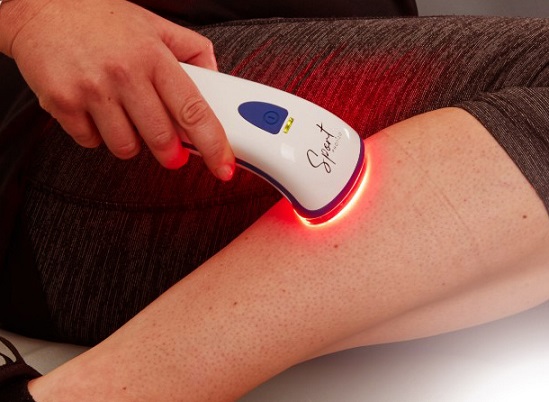Nikhil Prasad Fact checked by:Thailand Medical News Team Dec 31, 2024 3 months, 2 weeks, 11 hours, 5 minutes ago
Medical News: The COVID-19 pandemic, caused by the SARS-CoV-2 virus, has left an indelible mark on global health systems, not only due to the acute infections but also because of the persistent symptoms experienced by many survivors. Termed "long COVID," these ongoing issues include fatigue, brain fog, depression, muscular pain, and one of the most disabling conditions - persistent headaches and orofacial pain (OFP). The challenge lies in managing these symptoms effectively while minimizing the burden on the patients’ quality of life.
 Vascular Photobiomodulation Therapy Reduces Pain from Post COVID Conditions
Vascular Photobiomodulation Therapy Reduces Pain from Post COVID Conditions
A recent study by researchers from Nove de Julho University (UNINOVE) in São Paulo, Brazil, the Federal University of Bahia, and the Federal University of Rio Grande Do Sul, among others, explored an innovative approach to addressing long COVID symptoms. The study evaluated vascular photobiomodulation (VPBM), a low-intensity laser therapy designed to modulate pain and inflammation in patients suffering from tension-type headaches (TTH) and OFP.
Understanding Long COVID and Its Challenges
Long COVID encompasses a range of symptoms persisting weeks or even months after recovery from acute COVID-19. Among these, headaches rank as a significant concern due to their frequency and impact on daily activities. Studies estimate that 18% of long COVID patients report persistent headaches, often severe enough to disrupt work, social interactions, and basic functions. Orofacial pain, linked to both soft and hard tissues in the face and neck, adds to this burden.
This
Medical News report highlights a clinical trial that aimed to bring relief to these patients by using VPBM, a therapy known for stimulating tissue repair and reducing inflammation.
The Study Design
The pragmatic double-blind randomized trial included 40 participants divided into two groups - one receiving active VPBM treatment and the other a placebo (sham VPBM). Researchers employed a controlled setting, ensuring neither participants nor the evaluators knew the treatment allocations.
Participants in the VPBM group underwent treatment with a device emitting red light (660 nm wavelength) applied to the radial artery for 30 minutes weekly over four weeks. The sham group underwent identical procedures with inactive light to ensure blinding. Pain intensity and the impact of headaches on daily living were assessed using validated tools like the Brief Pain Inventory (BPI) and Headache Impact Test (HIT-6).
Key Findings
The VPBM group reported significant reductions in pain levels compared to the sham group. Highlights of the findings include:
-Pain Reduction
The average pain levels, measured by the Visual Analog Scale (VAS), dropped significantly in the VPBM group after four sessions. The effect was both consistent and progressive.
-Improvement in Daily Ac
tivities
Participants reported reduced pain interference in walking, working, sleeping, and enjoying life. Scores on the BPI questionnaire demonstrated notable improvements in these areas.
Impact on Headache Severity
While both groups saw some reduction in headache-related interference with daily living, the VPBM group experienced a more pronounced improvement. However, these changes were not statistically significant, suggesting a need for further research with larger sample sizes.
Mechanistic Insights
VPBM works by enhancing blood circulation and oxygen delivery, modulating inflammatory markers, and increasing ATP production in cells. This combination effectively addresses the physiological and biochemical contributors to persistent pain.
Implications for Treatment
VPBM offers a promising, non-invasive option for managing TTH and OFP in long COVID patients. Its ability to target pain pathways and inflammatory responses positions it as a valuable tool in addressing the multifaceted nature of long COVID symptoms.
Limitations of the Study
The trial had certain limitations, including its small sample size and short follow-up period. These factors may have restricted the ability to observe long-term outcomes and broader applications. Additionally, the study's focus on a single treatment protocol limits comparisons with other therapeutic options.
Conclusion
Vascular photobiomodulation presents an exciting frontier in the treatment of post-COVID-19 conditions. By significantly reducing pain and improving daily functioning, it addresses two major concerns of long COVID - disability and quality of life. Future studies should explore its long-term effects, scalability, and integration with other treatment modalities.
For patients struggling with persistent headaches and facial pain, VPBM therapy holds the potential to transform recovery pathways, offering relief where traditional methods may fall short. As the medical community continues to uncover the intricacies of long COVID, therapies like VPBM will play a critical role in shaping holistic care models.
The study findings were published in the peer-reviewed journal: Scientific Reports.
https://link.springer.com/article/10.1038/s41598-024-82412-9
For the latest COVID-19 News, keep on logging to Thailand
Medical News.
Read Also:
https://www.thailandmedical.news/news/covid-19-infections-and-vaccines-causes-elevation-of-amyloid-precursor-protein-which-contributes-to-persistent-headaches
https://www.thailandmedical.news/news/stop-treating-headaches-lightly-as-covid-19-can-cause-increased-intracranial-brain-pressure-which-can-be-dangerous
https://www.thailandmedical.news/news/covid-19-impact-on-migraine-sufferers
https://www.thailandmedical.news/news/dysfunctional-insulin-receptor-signaling-system-found-to-play-key-role-in-chronic-pain-and-diabetes-in-long-covid-patients
https://www.thailandmedical.news/news/sars-cov-2-nucleocapsid-protein-found-to-worsen-chronic-pain-in-those-exposed-to-covid-19
